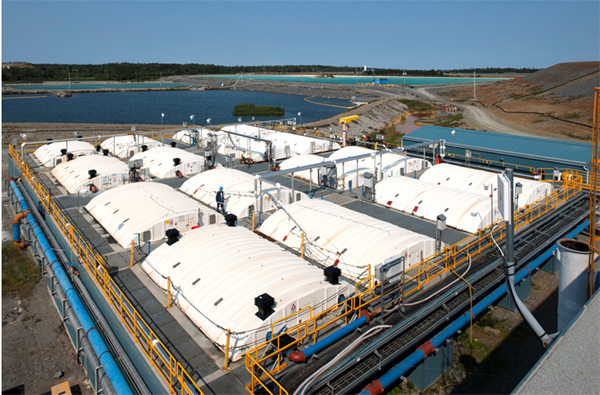|
|

|
  
Top Stories
Update 2019/6/3
Mining
This story is brought to you in part by

QUEBEC MINING COMPANY, A LEADER IN WATER STEWARDSHIP
By Suzanne Forcese
Abandoned mine sites are a legacy issue that the mining industry continues to address. The Manitou site near Val D'Or, Quebec, which operated from 1942 to 1979, was deserted when the last lease holder filed for bankruptcy. More than 11 million tonnes of tailings continued to generate acid drainage and release heavy metals into the environment in an area of 6.5 kilometres. With water at pH levels between 2 and 3, aquatic life had been unable to survive in the nearby Bourlamaque River when the Quebec Government assumed control of the most contaminated site in the province.
In 2006, Agnico Eagle Mines collaborated with Quebec's Ministry of Energy and Natural Resources to partner in the rehabilitation of the site. "Through discussion an idea emerged and finally we said you need a tailings pond. I have one that I'm stuck with. This might be a win-win for everyone." Ministry of Energy and Natural Resources Project Manager, Robert Lacroix stated.
WaterToday spoke with Dr. Michel Julien, Vice President at Agnico Eagle. "Water is so important," he told WT. "It interfaces with everything." Julien is also a member of the Mining Association of Canada (MAC) Board of Directors and the new Water Stewardship Protocol. Earlier this year, MAC introduced a new standard, the Water Stewardship Protocol, as part of its Towards Sustainable Mining®(TSM) initiative to further enhance environmental performance in the areas of Tailings Management, Energy and GHG Emissions Management, and Biodiversity Conservation Management Protocols.
"It is a new protocol but we have always taken the journey of water governance seriously," Julien continued. "We have been following a very successful example
set by Finland in creating the TSM and the Water Stewardship Protocol." Julien also refers to the importance and advantages of being a member of MAC. It is voluntary. There is a substantial fee and you definitely "have to play by the rules. However, merit disclosure comes with that. It also is something investors want to see. Investors are interested in risk management."
Agnico Eagle Mines has always been conscious of water stewardship. "The value of the program offers an opportunity for the industry to change its progress." Julien refers specifically to the Tailings Guide in the new protocol. Julian adds that Agnico has always been forward thinking in sustainable practices. In the Manitou site, Agnico was looking for a potential storage site of the inert tailings that would be produced by its Goldex mine. The goal of the reclamation project was to stop the acid generation by raising the water table above the reactive Manitou tailings with the deposition of the inert tailings coming from the Goldex mine 24 km away. The Goldex alkaline tailings were free of sulphide with good neutralization potential and the process did not use cyanide. This was a solution that eliminated the need to build a tailings pond while at the same time rehabilitating the site.
By 2017, 50% of the rehabilitation had been carried out and the effluent had reached neutral pH levels with a significant decrease in metal loadings to the Bourlamaque River and aquatic life has returned. By avoiding the creation of a tailings storage facility and reducing the use of natural resources such as sand, gravel, and clay to cover the Manitou tailings, wild-life habitats were created in optimizing land use.
As the partnership between Agnico and the Quebec Government continues, the benefits are clear. "Contamination has been reduced significantly and the delta
that was once excavated has now returned to its natural state. Not only did the government save money but they also avoided another land disturbance. I have seen moose and frogs," said Robert Lacroix, Project Manager (Minister of Energy and Natural Resources). Species of birds and ducks that were never there before can be seen. The area has also attracted Trumpeter Swans, a species that was not found before in the Abitibi region or Quebec.
"The Manitou Project is a demonstration that we can do things differently," said Louise Grondin (Senior Vice President Environment, Sustainable Development and People, Agnico Eagle). "What we do with all our projects is to start thinking upstream of the project, and more importantly to think about the project with a multi-disciplinary team." TSM and the new Water Stewardship Protocol heavily stress community engagement with an advisory panel representing various community groups and leaders.
That upstream thinking is evident in the company's flagship mine, LaRonde, located in the Abitibi region of northwestern Quebec. La Ronde has produced almost 6 million ounces of gold since it opened in 1988. La Ronde's 2.2 km deep Penna Shaft is now the deepest single-shaft in the Western Hemisphere. Agnico designed their Responsible Mining Management System (RMMS) an in-house safety, environment and social acceptability management system to continuously improve performance and to ensure that compliance and industry standards are met.
"All our projects have special sub-projects regarding water," Julien said. "Our state of the art biological water treatment plant in LaRonde uses live bacteria instead of chemicals eliminating all contaminants."
The LaRonde biological treatment plant was born out of the complexity of the LaRonde orebody that makes its water extremely complex. "We had water that was unique so we needed a solution that was unique. We worked with the best researchers and came up with the biological treatment solution. We started construction in 2003 and in 2004 the biological treatment plant was operational," Grondin stated.
The biological water treatment plant is able to process roughly 2 million cubic meters of water per year using bacteria that's already present in the environment. The effluent released into the environment is compliant and protects the habitat where final effluent is discharged. The system uses biological carriers, or Moving Bed Bio-reactors (MBBR). The MBBR's allow for a bio-film to form and be replaced during the treatment process. Due to the strong water agitation, the carriers collide with each other, releasing and replacing dead biofilm bacteria with new live bacteria. This allows for continuous renewal, making the treatment process more efficient. Huge improvements were made when the switch was made to the MBBR technology. In the past treatment system, bioreactors in the form of large biodiscs were used. However, it was more difficult to replace the biofilm. "Everyone who's come through this plant has contributed their ideas, their grain of salt to improve it. I think this plant is going to keep improving because everyone wants to become more and more efficient and productive".
An environmentally sustainable future for LaRonde and Manitou, as well as all mining projects is encapsulated in Michel Julien's words, "I'm just a guy...just an engineer who cares about the environment."

Photo Courtesy, Agnico Eagle Mines Limited
Biological Nitrogen Removal Water Treatment Plant, LaRonde, Quebec
In 2003 Agnico Eagle's LaRonde mine built a custom biological treatment plant to address water toxicity concerns and allow safe return of the treated water back into the environment in compliance with standards and regulation. This innovative process uses natural bacteria to eliminate contaminants form the water.
suzanne.f@watertoday.ca
|
|
|
Have a question? Give us a call 613-501-0175
All rights reserved 2025 - WATERTODAY - This material may not be reproduced in whole or in part and may not be distributed,
publicly performed, proxy cached or otherwise used, except with express permission.
|
| |